Yıllar boyunca birçok kullanıcımız bize WordPress veritabanlarından istenmeyen verilerin nasıl kaldırılacağını sordu. Bu veriler dağınık bir dolaptaki çöpler gibi birikebilir. Orada olduğunu bilirsiniz, ancak başa çıkmak çok zor gelebilir.
Dağınık bir WordPress veritabanı web sitenizi yavaşlatabilir, ziyaretçileri hayal kırıklığına uğratabilir ve satışları düşürebilir. Bu nedenle WordPress veritabanınızı temiz ve optimize tutmak web sitenizin performansı için çok önemlidir.
WPBeginner’da WordPress veritabanımızı düzenli olarak optimize ediyor ve kullanıcılarımızın da aynısını yapmasına yardımcı oluyoruz. Deneyimlerimize göre, başlamanın en kolay yolu ücretsiz WP-Optimize veritabanı eklentisidir. Ya da kendiniz uğraşmak istemiyorsanız WordPress bakım servisimizi kullanabilirsiniz.
Sitenizin performansını artırmaya hazırsanız, size WordPress veritabanınızı nasıl temizleyeceğinizi ve optimize edeceğinizi göstereceğiz. Bu, sitenizin sorunsuz ve verimli çalışmasını sağlayacaktır.
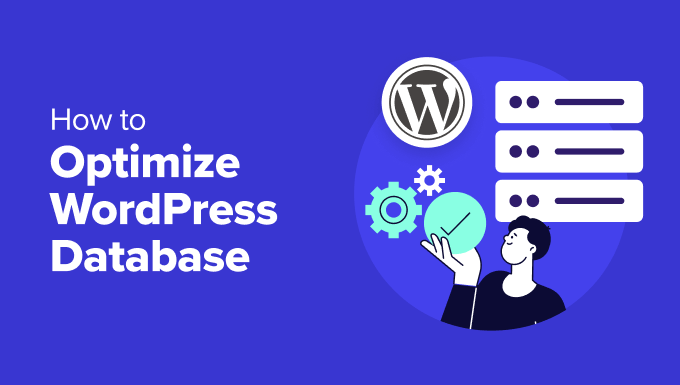
WordPress Veritabanınızı Neden Temizlemeli ve Optimize Etmelisiniz?
WordPress’i bir süredir kullanıyorsanız, veritabanınızda muhtemelen yazı revizyonları, spam yorumlar, çöp kutusu, geçici seçenekler, artık meta veriler vb. gibi çok sayıda gereksiz veri vardır.
Bu veriler WordPress veritabanı boyutunuzu artırır, bu da WordPress yedeklerinizin geri yüklenmesi için daha fazla disk alanı ve zaman gerekeceği anlamına gelir.
Bu istenmeyen verilerin kaldırılması ve temizlenmesi WordPress veritabanı boyutunuzu önemli ölçüde azaltır. Bu da daha hızlı yedekleme, daha kolay geri yükleme ve daha iyi veritabanı performansı sağlayacaktır.
Bunun yanı sıra, görüntüleri sıkıştırarak, JavaScript ve CSS dosyalarını küçülterek ve sitenizde önbellekleme ayarlayarak WordPress veritabanınızı da optimize edebilirsiniz. Bu, sitenizin performansını daha da artıracak ve ziyaretçilere hızlı bir kullanıcı deneyimi sunmanıza yardımcı olacaktır.
Profesyonel İpucu: Veritabanınızı temizlemeden ve optimize etmeden önce sitenizin eksiksiz bir WordPress yedeğini oluşturmanızı öneririz. Bir temizleme eklentisi tarafından yapılan değişiklikler geri alınamaz. Bu şekilde, bir şeylerin ters gitmesi durumunda sitenizi kolayca geri yükleyebilirsiniz.
Bununla birlikte, WordPress veritabanınızı nasıl optimize edebileceğinize bakalım.
Video Eğitimi
Videoyu beğenmediyseniz veya daha fazla talimata ihtiyacınız varsa, okumaya devam edin.
WordPress Veritabanınızı Tek Bir Tıklamayla Optimize Etme ve Temizleme
WordPress veritabanınızı temizlemenin ve optimize etmenin en kolay yolu WP-Optimize eklentisini kullanmaktır.
WP-Optimize, web sitenizin hızını ve performansını artırmayı amaçlayan popüler bir önbellekleme ve optimizasyon eklentisidir. Veritabanınızı temizleyebilir, resimlerinizi sıkıştırabilir, kullanılmayan resim boyutlarını kaldırabilir, içeriğinizi önbelleğe alabilir ve HTML, CSS ve JavaScript dosyalarının boyutunu azaltabilir.
Bu eklenti, popüler WordPress yedekleme eklentisi UpdraftPlus‘ın arkasındaki aynı ekip tarafından oluşturulmuştur. Daha fazla bilgi edinmek için detaylı WP-Optimize incelememize göz atın.
Bu eğitim için WP-Optimize ücretsiz sürümünü kullanacağız. Ayrıca zamanlama optimizasyonu, WP-CLI desteği, tembel yükleme, premium destek ve daha fazlası gibi daha fazla özellik sunan premium bir sürüm de var.
Yapmanız gereken ilk şey WP-Optimize eklentisini yüklemek ve etkinleştirmektir. Daha fazla ayrıntı için WordPress eklentisi yükleme hakkındaki adım adım kılavuzumuza bakın.
Etkinleştirmenin ardından, WordPress kontrol panelinden WP-Optimize ” Veritabanı sayfasına gidebilirsiniz. Ardından, optimizasyon ve temizlik için seçebileceğiniz farklı görevler olacaktır.
Örneğin, veritabanı tablolarını optimize edebilir, tüm gönderi revizyonlarını temizleyebilir, tüm otomatik taslak gönderileri temizleyebilir, spam ve çöpe atılan yorumları kaldırabilir ve daha fazlasını yapabilirsiniz.
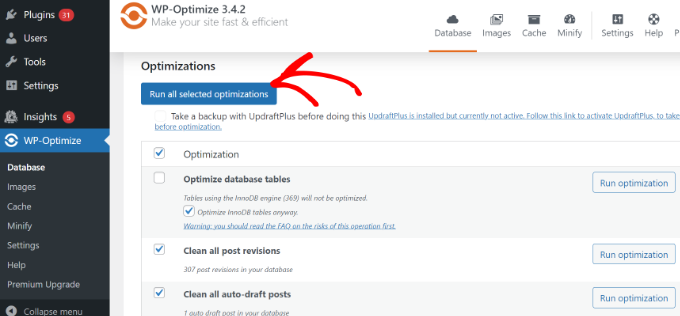
Farklı seçenekleri seçtikten sonra, devam edin ve en üstteki ‘Seçilen tüm optimizasyonları çalıştır’ düğmesine tıklayın.
Eklenti şimdi WordPress veritabanınızı optimize etmeye başlayacak ve size ilerlemeyi gösterecektir.
Ardından, WP-Optimize’da ‘Tablolar’ sekmesine geçebilirsiniz.
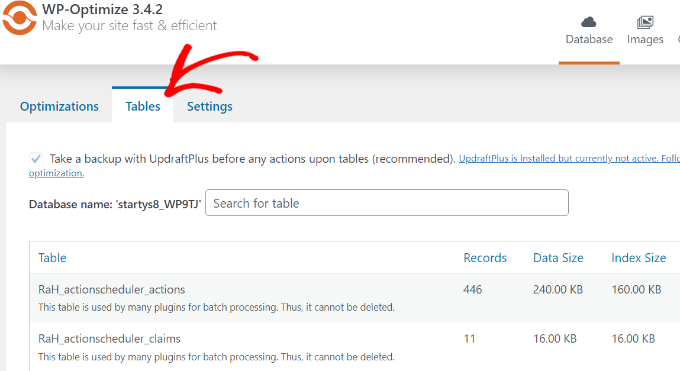
Eklenti, veritabanında etkin olmayan farklı tabloları gösterecektir.
Biraz yer açmak ve sitenizi daha da optimize etmek için bu tabloları kaldırabilirsiniz.
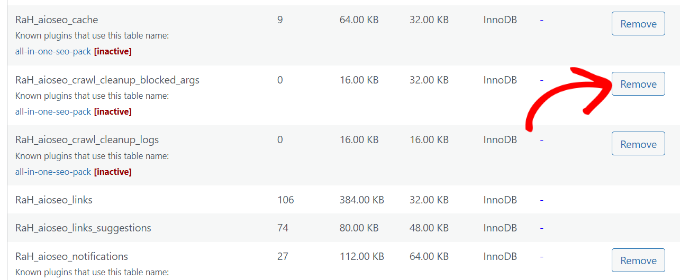
Son olarak, ‘Ayarlar’ sekmesine geçebilir ve kaç haftalık verinin saklanacağını seçebilirsiniz.
Veritabanınız için zamanlanmış temizlemeleri etkinleştirme seçeneği de vardır. Günlük, haftalık, iki haftada bir veya aylık temizlik planlayabilirsiniz.
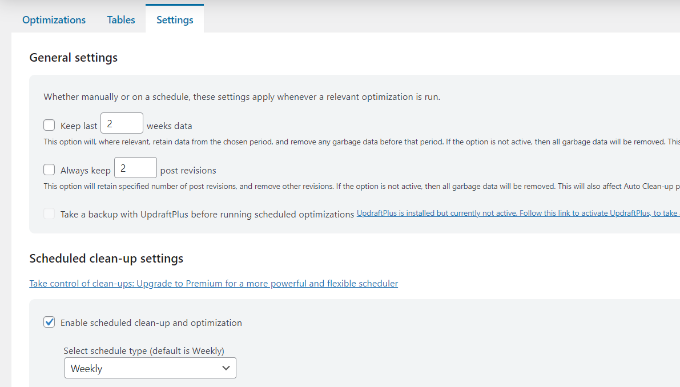
Hepsi bu kadar. WordPress veritabanınızı başarıyla optimize ettiniz ve temizlediniz!
WP-Optimize’da Ek Optimizasyon Özellikleri
WP-Optimize tarafından sunulan ve veritabanınızı optimize etmenize yardımcı olabilecek başka ek özellikler de vardır.
Şimdi bunlara ayrıntılı olarak bakalım.
Görsellerinizi Optimize Edin
‘Görüntüler’ sekmesine giderseniz veya WordPress yönetici panelinden WP-Optimize ” Görüntü ler’e giderseniz, sitenizdeki görüntüleri sıkıştırmak için seçenekler bulacaksınız.
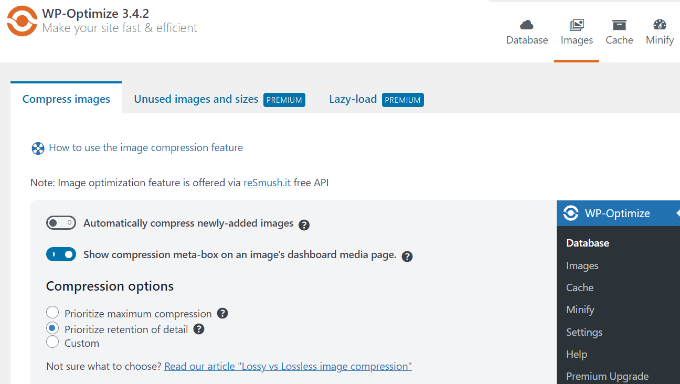
WP-Optimize ayrıca JPG ve PNG görüntülerini otomatik olarak WebP formatına dönüştürecek ve mümkün olduğunda bu sürümü sunacaktır.
Bu, önemli ölçüde daha küçük dosyalarla sonuçlanabilir ve WordPress veritabanlarının optimize edilmesine yardımcı olabilir.
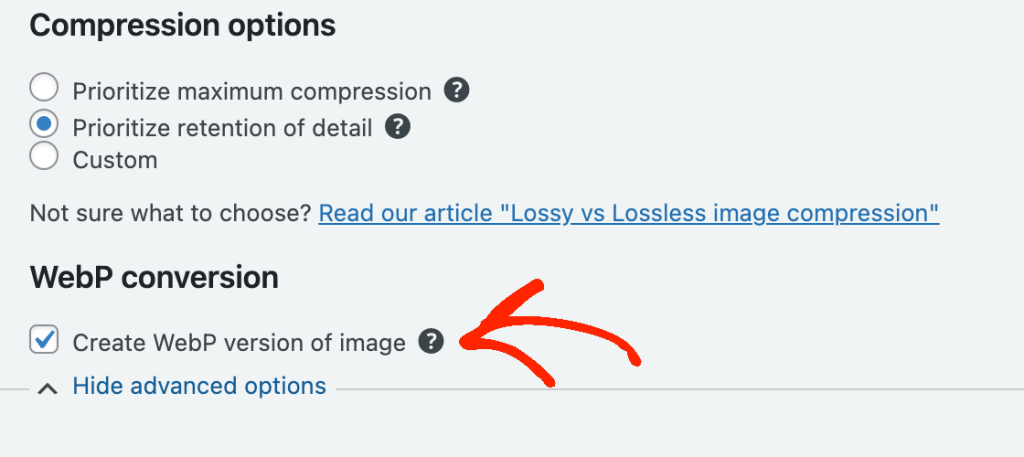
Görüntüleri kalite kaybı olmadan nasıl kolayca optimize edebileceğinize ilişkin kılavuzumuza da göz atmak isteyebilirsiniz.
Sayfa Önbelleğini Etkinleştir
Eklenti ayrıca sayfa önbelleğe almayı etkinleştirmek için bir seçenek sunar.
Bu, içeriğinizin bir kopyasını sunucuda depolayarak sitenizin hızını ve performansını artırabilir. Sunucu daha sonra sıfırdan indirmek yerine bu kopyayı ziyaretçilere gösterebilir.
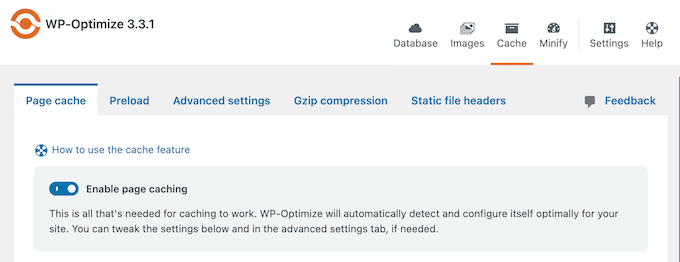
WP-Optimize ayrıca önbellek ayarlarını değiştirmenize de olanak tanır.
Kullanıcı rolüne, cihaza ve o anda oturum açıp açmadıklarına göre farklı içerikler sunabilirsiniz.
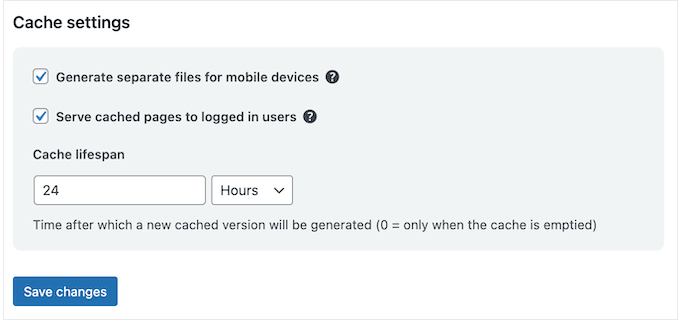
HTML, CSS ve JavaScript Dosyalarını Küçültün
WordPress veritabanınızı temizlemenin ve optimize etmenin bir başka yolu da küçültmeyi etkinleştirmektir.
Beyaz boşlukları, satırları ve gereksiz karakterleri kaynak koddan kaldırır. Bu, WordPress CSS ve JavaScript dosyalarınızın daha hızlı yüklenmesini sağlar.
WP-Optimize’da Minify sekmesine gidebilir ve ardından ‘Enable Minify’ seçeneğine tıklayabilirsiniz.
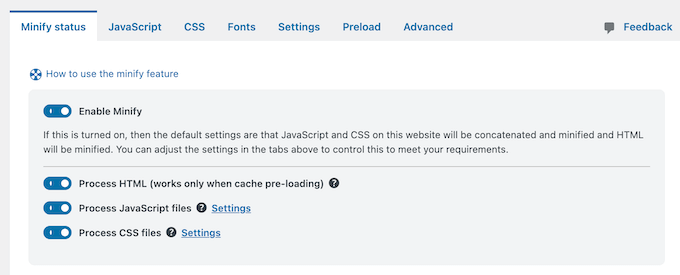
Eklenti küçültme işlemini otomatik olarak gerçekleştirecektir, ancak ayarlarda ince ayar yapabilir ve hangi CSS ve JavaScript dosyalarının hariç tutulacağını özelleştirebilirsiniz.
WP-Optimize’a alternatif: Veritabanını temizlemek için alternatif bir seçenek arıyorsanız, WP-Sweep eklentisini de kullanabilirsiniz. Tamamen ücretsizdir ve veritabanını temizlemek için tüm uygun WordPress silme işlevlerini kullanır. Bununla birlikte, WP-Optimize’de elde edeceğiniz optimizasyon seçeneklerinden yoksundur.
Bonus: WordPress Veritabanınızı Optimize Etmek için Uzmanlarla Çalışın
WordPress veritabanını optimize etmek sizin için çok zaman alıcı veya teknikse, tüm WordPress veritabanı bakım ihtiyaçlarınızı karşılaması için bir WordPress destek ajansı kiralamayı düşünün.
Piyasada birçok WordPress bakım hizmeti var, ancak biz uygun fiyatlı WordPress Bakım ve Destek Hizmetlerimizi öneriyoruz.
Web sitenizin temel WordPress veritabanı bakımıyla ilgili 7/24 çalışma süresi izleme, veritabanı hatalarını düzeltme, sitenizi performans için optimize etme, veritabanını temizleme ve daha fazlası dahil olmak üzere her şeyi halledebiliriz.

Ayrıca, şişirilmiş bir veritabanı da dahil olmak üzere web sitenizdeki tek seferlik sorunları hızlı ve güvenilir bir şekilde çözmek için Acil WordPress Desteği sunuyoruz. Ayrıca WordPress veritabanı bağlantı dizelerini, eklenti hatalarını, kırık bağlantıları ve çok daha fazlasını düzeltebiliriz.
Bunun yanı sıra, aralarından seçim yapabileceğiniz daha fazla Pro hizmet vardır. Saldırıya uğrayan sitenizi onarabilir, sitenizi hız için optimize edebilir, SEO optimizasyonu ile organik trafiği artırabilir ve daha fazlasını yapabilirsiniz.
Daha fazla ayrıntı için WPBeginner Pro Hizmetleri listemizin tamamına bakın.
WordPress Veritabanı Optimizasyonu için Yararlı Kaynaklar
Umarız bu makale WordPress veritabanınızı nasıl temizleyeceğinizi ve optimize edeceğinizi öğrenmenize yardımcı olmuştur. WordPress veritabanınızın sorunsuz ve hatasız çalıştığından emin olmak için diğer bazı kılavuzları ve yararlı öğreticileri de görmek isteyebilirsiniz:
- “WordPress Veritabanı Hatası Disk Dolu” Hatası Nasıl Giderilir
- WordPress Veritabanı Yedeklemesi Manuel Olarak Nasıl Yapılır (Adım Adım)
- WordPress Veritabanınızı Varsayılan Ayarlara Sıfırlama
- phpMyAdmin Kullanarak WordPress Veritabanı Nasıl Çoğaltılır
- En İyi WordPress Veritabanı Eklentileri – Uzman Seçimi
- WordPress’te Veritabanı Bağlantısı Kurulurken Oluşan Hata Nasıl Giderilir?
- WordPress Bakımı – Yeni Başlayanlar İçin Nihai Kılavuz
If you liked this article, then please subscribe to our YouTube Channel for WordPress video tutorials. You can also find us on Twitter and Facebook.





Usman
Is it necessary to take a backup first then Optimize the Database?
WPBeginner Support
While not necessary, we strongly recommend it on the off chance something goes wrong or you run into an error. While it is rare for that to happen, it is better to be safe
Admin
Nikita Shevchenko
Hello! Great article! I have one question. Can I use this plugin simultaneously with autooptimize and wp3 total cache plugins?
Editorial Staff
This is a plugin that you can use and then disable once you’re done cleaning the database. We recommend using this plugin once every 6 – 12 months.
Admin
ANTESH KUMAR SINGH
How to fix “Optimize InnoDB tables anyway” in WP-Optimize plugin?
Have any solution to optimize InnoDB tables in WordPress?
James Finn
Hey guys,
In this article:
/plugins/how-to-clean-up-your-wordpress-database-for-improved-performance/
It is stated:
“… the main [benefit of wp-sweep over wp-optimize] is that it uses proper WordPress delete functions as much as possible instead of running direct delete MySQL queries. Whereas the WP-Optimize plugin uses direct delete SQL queries which can leave orphaned data left behind. In other words, WP-Sweep is a better coded plugin than WP-Optimize.”
Quote and closed quote!
Perhaps you can explain why you have two clearly contradictory articles published on your site at the same time. Edit one, or the other, please!
An incredibly influential site such as this needs more attentive editorial review.
Thanks bunches!
WPBeginner Support
Hi James,
We often recommend plugins that do the same thing. If there is a difference, then we also try to highlight it as you have quoted. One great thing about WordPress is that you often have plenty of excellent solutions for a problem.
Admin
Neal Umphred
You used to recommend WP-Sweep for this service:
(https://www.wpbeginner.com/plugins/how-to-clean-up-your-wordpress-database-for-improved-performance/).
What happened?
WPBeginner Support
Hey Neal,
We still recommend it. You can use either of these two plugins for the job.
Admin
Neal Umphred
Thanks for the response!
If I use WP-Optimize, do I need an occasional clean-up from WP-Sweep?
Ian Spare
In a previous article (https://www.wpbeginner.com/plugins/delete-old-post-revisions-in-wordpress-with-better-delete-revision/) you made an update stating that post revisions would not impact database performance. Are you now saying they do?
Mayank Debnath
Yea! I am confused too ..
Ian Spare
It’s clear that actions like removing post revisions will make no difference whatsoever to “database performance”. I think the confusion is caused by some misunderstanding about how relational databases work and specifically about how indexed queries are executed.
The problem is exacerbated by so many WordPress users being quite certain that optimising their database is required. Given that relations databases and related technologies like Indexed Sequential Access Method (ISAM) on which the internals are based have been around for some 50 years it ought to be well understood.
The entire point of using a database is to access data in a way that scalable. The time it takes to find an indexed record, for example, a published WordPress post, is not dependent on the size of the database.
I’d invite the authors of this article to actually test this. Create a WordPress install and create a few thousand revisions of a post. You’ll find it makes zero difference to performance.
The time it takes to find a post is dependent on the number of seeks it takes. You can work this out like this:
log(row_count) / log(index_block_length / 3 * 2 / (index_length + data_pointer_length)) + 1
I can tell you that the number of seeks will not increase between thousands of revisions and tens of thousands. You’ll get an extra seek when you enter the hundred of thousands of rows. But, the odds are it’s in query cache anyway so it won’t matter.
I know from testing, for no reason at all, that having a post with 200,000 revisions is just as quick to access as one with none.
Matilda Moo
So if my host is saying my sites keep going down because i need to optimise my db, really it’s the number of hits/seeks that my hosting can’t cope with?
Rob Smelik
I can’t speak for the author but thought I would throw some thoughts out there.
When it comes to loading your site on the front end, WordPress is actually smart enough to ignore previous revisions as it loads individual pages. However, overall database bloat can slow down a site if you have a large site with many pages and posts. Post revisions do add to the overall size of a database but are certainly not the only contributor. That being said… anything that you can do to reduce the size of your database will keep your site running at peak performance.
I have been using WP Optimize for years both on personal and client sites and can honestly say it does an excellent job at keeping your database clean. I have also noticed speed boosts when installing on older sites with larger databases that haven’t been optimized. With regard to post revisions, It has a great setting that allows you to limit the number of stored revisions. I keep it set at about 10 which is more than enough for post revision backup purposes.
I believe the premium version of the plugin also lets you schedule optimization cycles without having to manually go in and click the optimize button.
WPBeginner Support
Hi Ian Spare,
Post revisions don’t affect database performance or your site’s page load times. However, they do increase database size. On older websites with lots of content, cleaning up or limiting post revisions can significantly reduce database backup file size. This means you will be to do on-demand backups, restore from backups, or move backup files around a bit faster. It will also save space on your cloud storage service where you save your backups.
Admin
Ian Spare
Thanks, I think you’re moving closer to an accurate position now.
I think we can dismiss size considerations pretty quickly. A MySQL dump of WordPress database is pretty small. It’s highly compressible data as well, I’d suggest as pure text with a midrange compressional level you’d get around 10:1.
So I suggest this site might have 1000 posts with 10 revisions per post which for some (unlikely) reason are all the same size (in practice, they’ll be smaller you’d think). And we’ll say a post is about 2800 characters in size because that’s around the size of your post here, we’ll add a bit because it’s not going to make a lot of difference and say 3000 chars.
1000 * 10 * 3000 = 30000000
or about 28mb which is going to be around 2.8mb in compressed size.
Which is, in technical terms, diddly squat. A handful of images at best.
The footprint of an average WordPress post is very often the associated images. They’ll need backing up as well. That footprint will only be trivially impacted by the number of revisions.
There’s not a realistic chance these backups will fit into, for example, the free cloud storage of 2gb on Dropbox. So, anyone storing backups in the cloud might well have paid for a service which will be delivering unlimited storage (ie the jetpack backup service) or terabytes.
It’s hardly a realistic concern to be bothered about a couple of mb in size for a backup file. I appreciate there’ll be some who’ll produce a contrived use case where 10k makes a difference which is fine, I’m just saying in general usage, this is nothing.